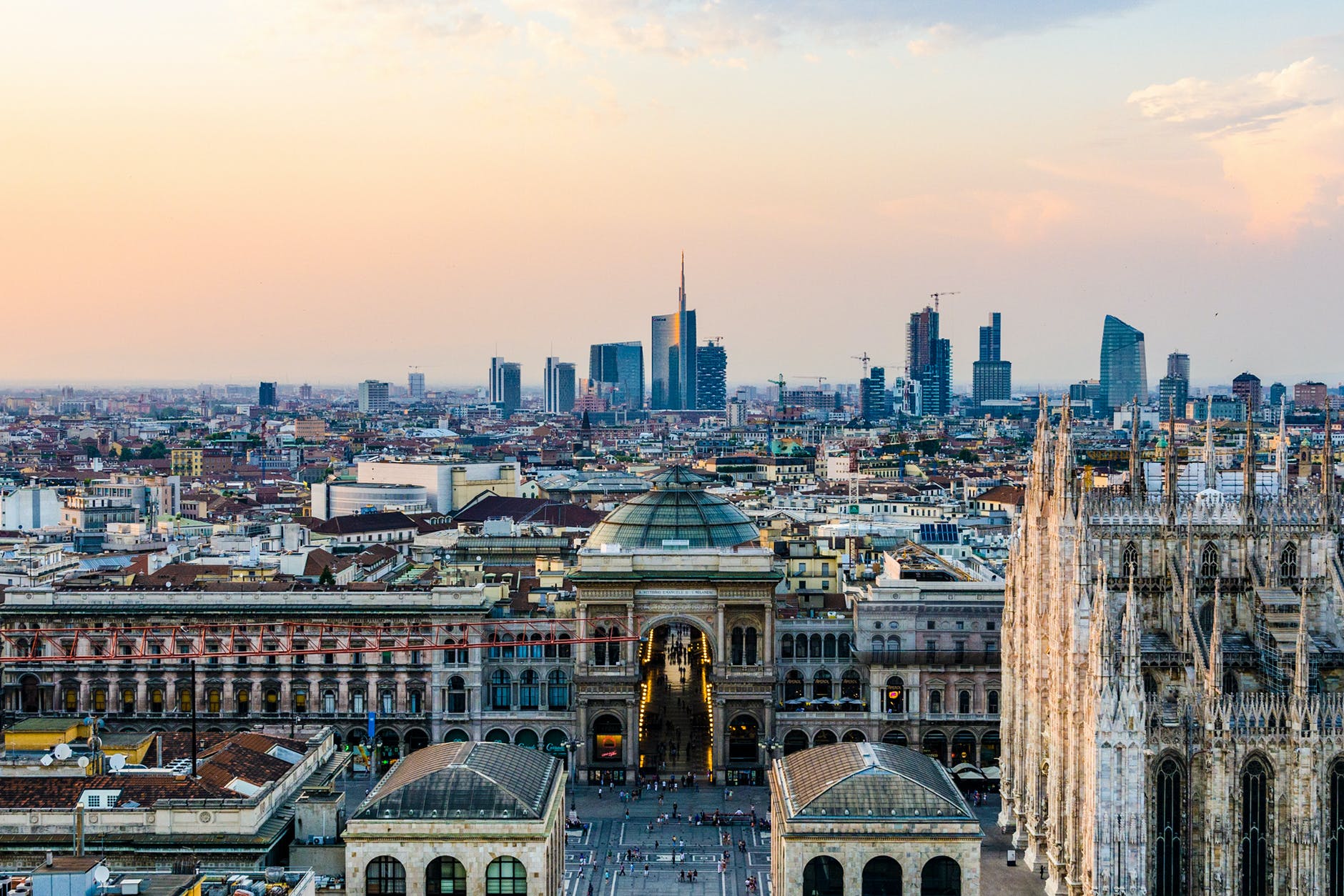What comes to mind when you think of Milan? Business? Fashion?
Valid answers and those are certainly part of Milan, but there is so much more!
Experiencing a massive transformation since the Expo in 2015, the vibrant city has more to offer now than ever before.
9 Unique Things to Do & See in Milan
#1 Street Art Tour
Milan was the first city in Italy that developed an independent street art movement in the 1980s. It evolved during the 1990s and 2000s, and it’s now one of the most exciting and varied in Europe.
Join an expert local guide or, better yet, the street artists themselves to discover the incredible art sprinkled throughout the city.
As street art is irreversibly intertwined with the social life of the neighborhoods, you’ll learn about the social and urban history of the districts during the tour.
#2 Cocktails & Canals
Did you know that Milan has a massive network of canals linking it to Maggiore and Como Lake and the Adriatic Sea?
The history of the canals is fascinating; dating back to the 1100s, it includes connections to the construction of the Duomo and Leonardo DaVinci.
Many of the canals were covered from the 1920s to the 60s, but you can still visit some of the canals today.
The Naviglio Grande is a trendy spot for aperitivo. Go at sunset when the setting sun’s colors reflect off the water, and try a craft cocktail at Pinch.
Another way to visit the canals is by boat! Canal cruises are a great way to see even more of the canals and discover where they lead and the villas, villages, churches, and more that lie along their banks.
#3 Historic Boutiques
Visiting the historic boutiques in Milan is like taking a step back in time.
There’s the mirrored barbershop with the black patent leather chairs and experienced barbers in long, white coats.
There’s the legendary fur shop Pellicceria Lagori Francesco, which has been in business since 1944.
The famous Borsalino hat shop opened in the Galleria Emmanuele in 1883. The hats became iconic when Hollywood adopted them, and they started appearing in films such as Casablanca.
The Vetrerie di Empoli has a rainbow of intricate glassware.
You’ll also find the Grand Hotel in this same district, conveniently located down the street from La Scala. Giuseppe Verdi often stayed at the hotel and ultimately died there in 1901.
Albert Einstein also spent time in the neighborhood before going to university.
#4 Active Milan
When you think of Milan, you probably do not think of greenery and outdoor activities.
Still, in recent years, the city has made a significant push to become greener both in terms of sustainability efforts and creating more green spaces.
A great way to explore the city is with a running or biking tour. You can visit famous sites or explore lesser-known areas in the city and its surrounding areas.
The running tours are from 5-20km, and the biking adventures can be a half or full day with a regular or electronic bike.
#5 Bohemian Milan
The Brera neighborhood, which in the past wasn’t even located in the city, but was a countryside area adjacent to the city, started to change in 1776 when Maria Teresa d’Austria built the Accademia delle Belle Arte (Academy of Fine Arts).
The Academy revolutionized the area and caused it to become a cultural hotspot full of artists, students, and intellectuals.
Today the Academy of Fine Arts is home to the Braidense National Library, the Astronomical Museum, the Botanical Garden, and the outstanding Pinacoteca.
The latter is one of Italy’s first public art museums and houses one of Italy’s largest and most precious art collections. In its 40 rooms, you will find paintings by Raffaello, Caravaggio, and Modigliani, to mention a few.
The neighborhood has a colorful past. Bar Jamaica was founded in 1911 and quickly gained popularity thanks to having an espresso machine and telephone, two rarities at that time. It was frequented by influential men of the day, including Benito Mussolini.
Brera was also a red-light district in the past with many brothels, the majority concentrated in Via San Carpoforo.
Nowadays, the area is a design district with lots of boutiques, art shops, antique shops.
#6 DaVinci’s Vineyards
DaVinci certainly left his mark on Milan.
From his crucial effect on the canal system to his masterpiece, the Last Supper, you can find evidence of DaVinci’s time in Milan spread throughout the city.
Did you know that he also had a vineyard in the city?
The Duke of Milan, Ludovico il Moro, tasked Leonardo with painting the Last Supper in 1495.
In 1498 to show his gratitude for Leonardo’s work on the masterpiece, Ludovico gifted him with a parcel of land complete with vineyards just steps from Santa Maria alle Grazie where the Last Supper is painted.
The vineyards quickly became one of Leonardo’s most valued possessions and a place he would go for tranquility and reflection.
The vineyards are visitable today, and it’s even possible to buy a bottle of the wine, Malvasia di Milano, which is still produced there.
#7 Milan’s Underground
By this point, it should be evident that there is a lot more than meets the eye in Milan.
Nowhere is that truer than when you go underground.
Meters under the city exists another world.
Unsurprisingly there are many crypts, but there’s also a Roman Theater hidden under the Italian Stock Exchange and a Roman forum beneath a library.
Even more particular is the ossuary decorated with human bones from closed cemeteries.
Under the Sforzesco Castle, there’s a system of tunnels and passages used to flee the city during attacks.
In the 1920s, day hotels were constructed underground in the art deco and liberty style. They offered wellness and tourist services.
Air raid shelters from WWII, including one with a school and another that could house up to 400 people, also exist under the city.
#8 An Architectural Powerhouse
Milan is the most critical laboratory of modern and contemporary architecture in Italy.
Spanning the last century, Milan has been a fascinating and innovative space for architects.
Some of the most influential architects have worked in Milan, including Zaha Hadid, Herzog and de Meuron, and Rem Koolhaus.
The baton has now been passed to a new generation of architects, including Stefano Boeri. He was behind the captivating Vertical Forest.
Taking a tour with a local architect is a fantastic way to explore this side of Milan and journey through the history of the last 100 years to understand the city’s impact on the world of architecture and how we arrived where we are today.
#9 Milan’s House Museums
A superb concept in Milan and something not to be missed is the house museums. Private residences have been transformed into museums displaying the beautiful collections of their past owners.
There are four of them in Milan, and each is unique and deserving of a visit.
The Bagatti Valsecchi Museum is the 19th-century residence of two brothers who wanted to create a Renaissance-style home with all the modern conveniences of the 19th century. It was the first house to have hot water, a shower, and electricity. The house is full of art and furniture from the 15th century.
Museo Poldi Pezzoli is the home of art collector Gian Giacomo Poldi Pezzoli. You can view his eclectic collection of over 5000 works of art.
Moving to the 20th century, the Boschi di Stefano Museum displays the 20th-century Italian art collection of Antonio Boschi and his wife, Marieda Di Stefano.
Lastly, the Necchi Campiglio Villa is a marvel in the center of Milan. The villa is surrounded by a lush, tranquil garden complete with a swimming pool and tennis court. Inside, the furnishings are art deco, and it is filled with works by great artists, including Picasso and Modigliani. It provides an intriguing glimpse into the glamorous world of Milan in the years between the world wars.
➡ Which experience would you choose to do? I would love to hear! Join the conversation over on Instagram.

